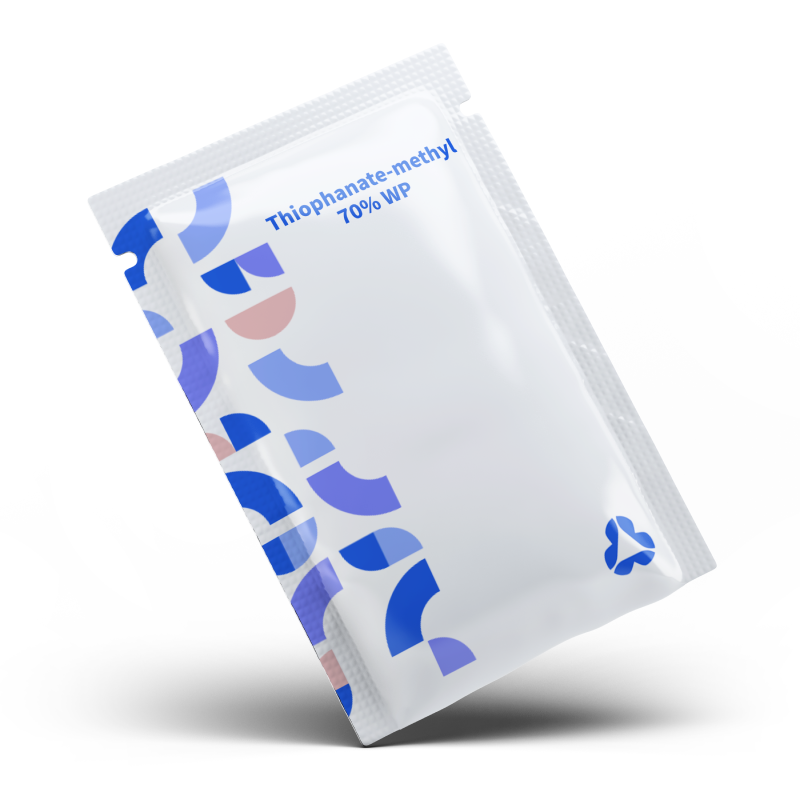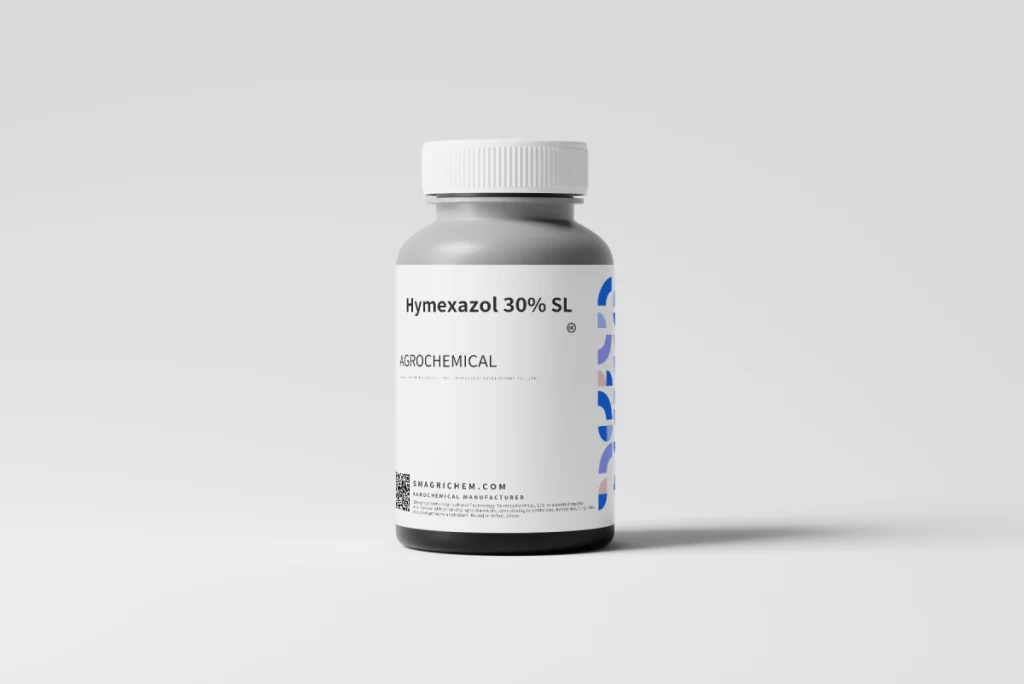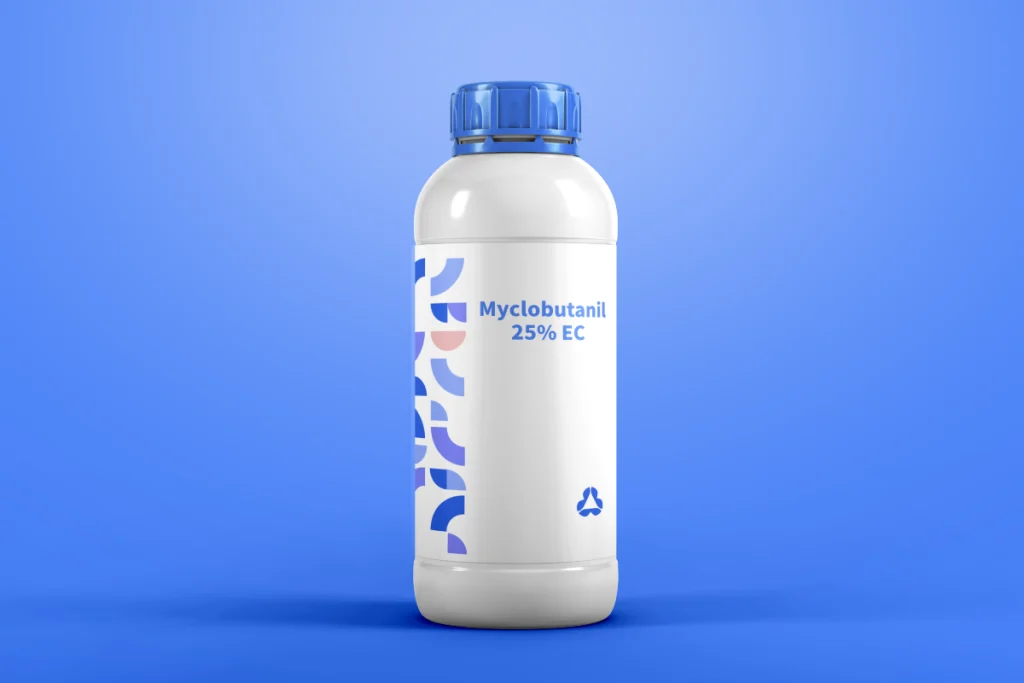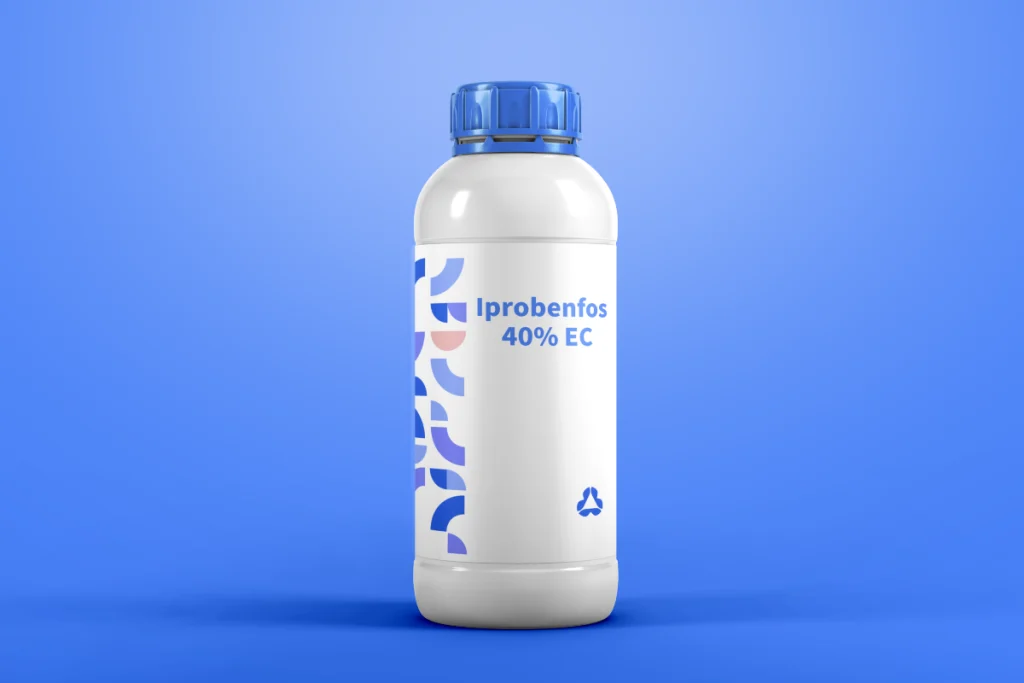Product Overview
| Feature |
Description |
| Product Name |
Thiophanate-methyl Fungicide |
| Active Ingredient |
Thiophanate-methyl |
| Chemical Class |
Benzimidazole |
| CAS Number |
23564-05-8 |
| Molecular Formula |
C₁₂H₁₄N₄O₄S₂ |
| Formulations |
70% WP, 50% WP, 97% TC |
| Application Methods |
Foliar spray, seed treatment |
| Target Diseases |
Sheath blight, rice blast, scab, powdery mildew, black spot, leaf mold |
| Applicable Crops |
Rice, wheat, cotton, peanuts, tomatoes, melons, apple, pear, sweet potato |
| Shelf Life |
2 years (under proper storage) |
| Regulatory Documents |
COA, MSDS, ISO, SGS available |
Mode of Action & Biological Efficacy
Thiophanate-methyl is metabolized into methyl benzimidazole carbamate (MBC) inside plants. This metabolite inhibits fungal mitosis by disrupting spindle formation during cell division, preventing the spread of fungal spores and stopping active infections.
Key Benefits:
-
Systemic Movement: Translocates via xylem and adjacent tissues to protect new growth.
-
Preventive & Curative: Controls surface infections and internal mycelium development.
-
Broad-Spectrum Activity: Effective against ascomycetes, basidiomycetes, and deuteromycetes.
-
Resistance Management: Acts on multiple pathways, reducing resistance risk.
Application & Recommended Dosage
| Crop |
Target Disease |
Dosage |
Application Method |
| Rice |
Sheath blight, rice blast |
1500–2145 g/ha |
Foliar spray |
| Wheat |
Scab |
1065–1500 g/ha |
Foliar spray |
| Pear |
Scab |
1600–2000 times dilution |
Foliar spray |
| Apple |
Ring disease |
1000 times dilution |
Foliar spray |
| Tomato |
Leaf mold |
540–810 g/ha |
Foliar spray |
| Melon |
Powdery mildew |
480–720 g/ha |
Foliar spray |
| Sweet Potato |
Black spot |
1600–2000 times dilution |
Seed soaking |
Application Timing:
Best Practices:
-
Ensure complete leaf and canopy coverage.
-
Avoid spraying under intense sunlight or right before rainfall.
-
Follow local PHIs (Pre-Harvest Intervals): typically 7–14 days.
Advantages & Technical Highlights
✅ 1. Broad-Spectrum Control
Controls a wide array of fungal pathogens, including:
-
Rice: Sheath blight, rice blast
-
Fruits: Scab, ring disease
-
Vegetables: Leaf mold, powdery mildew
-
Wheat & Peanuts: Fusarium diseases
✅ 2. Systemic, Long-Lasting Protection
Moves inside plant tissues to protect both treated and newly emerging parts.
✅ 3. Dual Action – Preventive & Curative
Mitotic disruption ensures both early intervention and control of active infections.
✅ 4. Resistance Management
Multi-site activity helps delay resistance buildup in pathogen populations.
✅ 5. Wide Crop Compatibility
Suitable for cereals, fruits, vegetables, and root crops.
✅ 6. Crop Vigor Enhancement
Promotes healthy foliage and improved yield by protecting critical growth stages.
Formulations, Packaging & OEM Services
Formulation Types:
-
70% WP (Wettable Powder): Ideal for foliar spraying on fruits and vegetables.
-
50% WP: Economical option for moderate disease pressure.
-
97% TC (Technical Concentrate): For bulk formulation, industrial processing.
Packaging Options:
| Packaging Type |
Size Options |
| Bags |
100g, 250g, 500g, 1kg, 5kg |
| Drums |
10kg, 25kg |
| Bottles (SL/SC) |
100ml to 1L |
| Bulk |
Up to 1000kg |
Custom packaging with your logo, brand, language, and design is available to support regional market needs.
OEM / ODM & Regulatory Support
We offer complete private label and contract manufacturing support, including:
-
Custom formulation and concentration
-
Label design and multi-language packaging
-
COA, MSDS, TDS, and regulatory registration support
-
Assistance with local market entry and compliance
Whether you are a distributor, importer, or agrochemical brand, Shengmao is your trusted partner for high-quality fungicides.
Usage Precautions & Environmental Safety
Safety Guidelines:
-
Use gloves, goggles, long sleeves, and masks during application.
-
Avoid inhalation and skin/eye contact.
-
Do not spray during strong wind, extreme heat, or rain.
Environmental Impact:
Storage & Disposal:
-
Store in a cool, dry, and ventilated area.
-
Keep away from children and animals.
-
Triple-rinse containers; dispose of per local regulations.
Why Choose Shengmao as Your Thiophanate-Methyl Supplier?
-
✔ ISO-Certified Manufacturing
-
✔ Global Export Experience
-
✔ Custom OEM/ODM Solutions
-
✔ Reliable Bulk Supply & Logistics
-
✔ Regulatory Support Documents (COA, MSDS, SGS)
We empower agricultural brands and distributors with quality-assured, high-performance fungicides tailored for your market.
FAQ: Comprehensive Guide to Thiophanate Methyl
1. What is Thiophanate Methyl?
Thiophanate Methyl is a broad-spectrum systemic fungicide belonging to the benzimidazole group. It is widely used in agriculture and horticulture to control various fungal diseases in crops, turfgrass, and ornamental plants. Upon application, it is absorbed and translocated within the plant, providing both protective and curative actions.
2. What is Thiophanate Methyl Used For?
Thiophanate Methyl is primarily used to treat and prevent fungal diseases such as:
-
Powdery mildew
-
Gray mold (Botrytis)
-
Anthracnose
-
Fusarium wilt
-
Leaf spot
-
Brown patch
It is effective on crops like vegetables, fruits, cereals, ornamentals, and turfgrass.
3. How Does Thiophanate Methyl Work (Mode of Action)?
Thiophanate Methyl works by inhibiting fungal cell division. Once inside the plant, it is converted into carbendazim, which disrupts mitosis in the fungus by interfering with microtubule formation. This halts fungal growth and reproduction, providing systemic protection throughout the plant.
4. Thiophanate Methyl Uses and Fungicide Applications
Common applications include:
-
Field crops: soybeans, wheat, peanuts, and cotton
-
Fruits and vegetables: strawberries, tomatoes, cucumbers, grapes
-
Ornamentals and flowers: roses, chrysanthemums, geraniums
-
Turf management: golf courses, athletic fields, and lawns
It can be applied as a foliar spray, seed treatment, or soil drench, depending on the crop and fungal issue.
5. Thiophanate Methyl Fungicide in Combination with Other Fungicides
To prevent resistance and enhance spectrum, Thiophanate Methyl is often mixed with fungicides like:
6. Thiophanate Methyl vs. Other Fungicides (Azoxystrobin, Propiconazole, Myclobutanil)
| Fungicide |
Mode of Action |
Best For |
Resistance Risk |
Systemic? |
| Thiophanate Methyl |
Cell division inhibition |
Broad fungal control |
Medium (use in rotation) |
Yes |
| Azoxystrobin |
Mitochondrial respiration inhibition |
Downy mildew, rusts |
Medium to High |
Yes |
| Propiconazole |
Sterol biosynthesis inhibitor |
Rusts, leaf spots |
Medium |
Yes |
| Myclobutanil |
Demethylation inhibitor (DMI) |
Powdery mildew, scab |
Low to Medium |
Yes |
Thiophanate Methyl is best used as part of an integrated fungicide program to prevent resistance and maintain efficacy.
7. Where to Buy Thiophanate Methyl?
Thiophanate Methyl fungicide is available from:
-
Agrochemical suppliers and distributors
-
Online agricultural retailers (e.g., Amazon, Alibaba, CropLife stores)
-
Local farm supply stores
Always ensure the product is registered and labeled for your region and crop.
8. Thiophanate Methyl 70 WP Price
Prices vary by quantity, brand, and region. On average:
9. Chlorothalonil and Thiophanate Methyl-Based Fungicides
Combining Chlorothalonil (a contact fungicide) with Thiophanate Methyl offers:
-
Dual modes of action (systemic + contact)
-
Enhanced disease spectrum
-
Resistance management
These combinations are popular in turf care and crop protection for diseases like leaf spot, dollar spot, and brown patch.
10. Fungicides Containing Thiophanate Methyl and Chlorothalonil
Some common formulations include:
-
Spectro 90WDG
-
Cleary’s 3336 Plus
-
Fungo Flo
These products are widely used on lawns, golf courses, ornamental plants, and field crops, offering robust and lasting fungal control.




